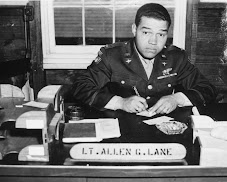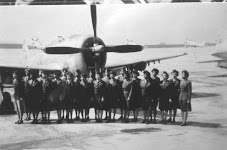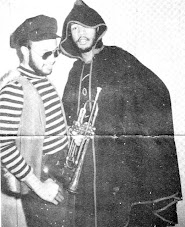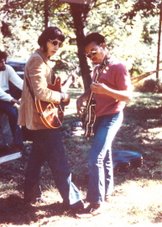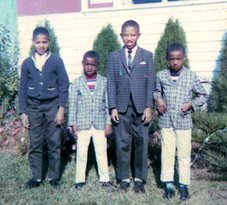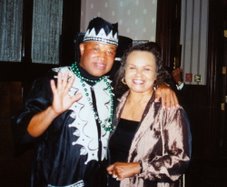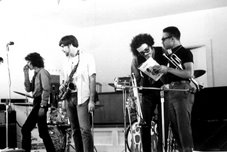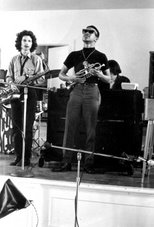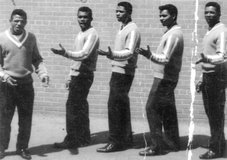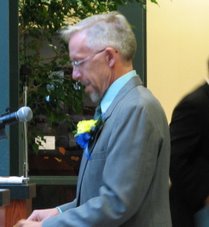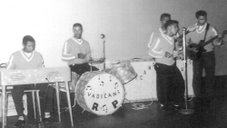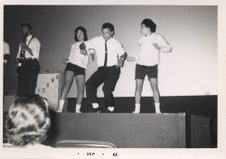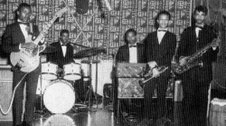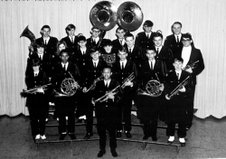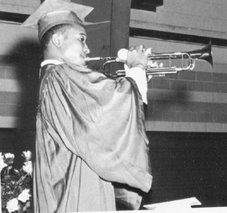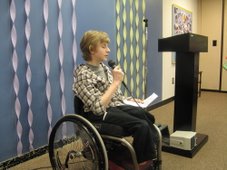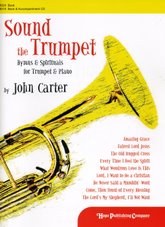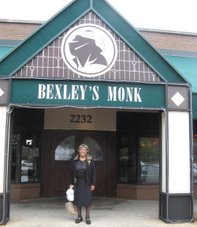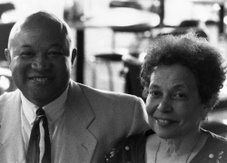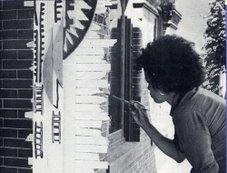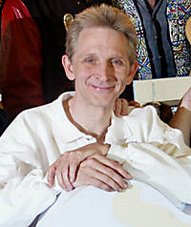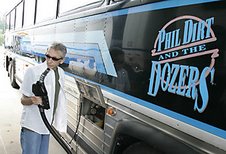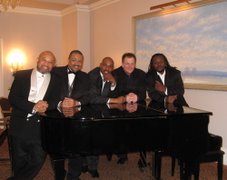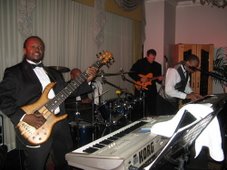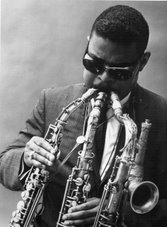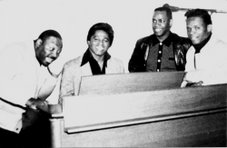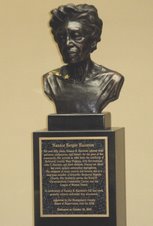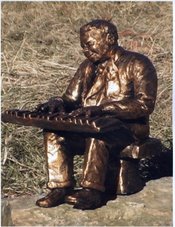
Jazz musicians, writers and critics are almost universal in turning a sour face when the mention of a society bend or sweet music is made. Sweet music never fails to awaken visions of the syrupy, vibrato sounds of
Guy Lombardo’s Royal Canadians or of the
Paul Whiteman Band. Whereas the lean, muscular, aggressive syncopation of
King Oliver’s Creole Jazz Band, Louis Armstrong's Hot Five, the Duke Ellington Orchestra, Count Basie or
Bennie Goodman was hotter, thus preferable to jazz snobs.
But in the 1920s, there was a Columbus Ohio's society orchestra, led by pianist
Sammy Stewart, that became the leading band in the music centers Chicago and New York throughout the decade. Stewart's bands catered to more generalized audiences such as hotels, ballrooms, stage shows, supper clubs, movie houses and more often, they performed in a non-jazz set thing.
Sammy Stewart was born in Circleville, Ohio, in 1891 and spent most of his early life living on Columbus's Mount Vernon Avenue. He was raised by his mother to be a respectful boy, went to Garfield school, graduated from Columbus East High School and was regarded as an outstanding pianist. Local booking agent and violinist
Charlie Parker apprenticed young Stewart and allowed him to become a member of
Parker's Popular Players. The orchestra performed in many of the area's prestigious hotels, the Deshler Wallick, the Kaiserhoff and in the the Secore in Toledo, Ohio.
Soon Sammy was to carry away many of his sidekicks from the Parker band to start another unit in 1918. Three years after he started the Sammy Stewart orchestra, Sammy contracted for a year at the Secore. The band's most important break came in 1922 when Sammy closed a lucrative deal with the exclusive Ritz, a supper Club in Detroit Michigan.
“When you contracted a job in those days it wasn't for a week, it was for year,” remembers
Bill Stewart, not related to Sammy, but a saxophonist mainstay of the band. The rich contract was big enough financially to attract other colleagues from the Parker orchestra. At this time the Stewart orchestra include
Paul Jordan, violin,
Renna “Fats”, Robbins, trumpet, bassoon, his brother
Millard Robbins, bass, flute, vocals,
Frank Fowler, sax,
Lawrence “Dick” Dixon, guitar, cello,
Mance Worley, trombone,
Harley Washington, sax, clarinet
Claudius Forney, trumpet and cello
The Ritz engagements solidified the band and their fame was spreading. “Sammy only chose the best musician available,” says
Roy Butler, who later joined the band at their opening in Chicago. “He had the respect of his men, who were chosen for their character in the first place and therefore, no disciplinary action was ever necessary.” According to Bill Stewart, who also joined the band in Chicago, “Sammy's contracts were so good that he could hire who he wanted and he preferred musicians from Ohio.”
The 1923 opening of
Sammy Stewart and his Ten Knights of Syncopation at Chicago's Entertainer's Cafe was a sensation. For several months, long lines appeared at the doors of 35th Street to hear this great band from Columbus, Ohio. “We the first Negro organized orchestra playing special arrangements to hit Chicago,” says Roy Butler. “We were not known for playing hot or jazz music, but more on the sweet or semi-classical style, with which
Paul Whiteman later made headlines. Bill Stewart relates, “We did all kinds of overtures, the
William Tell included. We're the first negro orchestra to play Gershwin’s
Rhapsody in Blue in its entirety. On one occasion, we auditioned and got a contract because of that and built a stage show around it.”
The entertainer's cafe job ended prematurely when the federal government, resulting from an investigation by
Elliot Ness’ Untouchables, padlocked the club for prohibition violations; they serve drinks and teacups. However blessings were disguised as Sammy then negotiated with
Joe Glaser, famed booking agent and later manager for
Louis Armstrong, to open at the Sunset Cafe. The Sunset was another famous black and tan, located at 35th and Calumet in Chicago and the Sammy Stewart Orchestra, at its peak, enjoyed great popularity and success for several years surrounding 1924-25.
Bill Stewart remembers, “While we were at the Sunset all the musicians used to come over and see us. J
elly Roll Morton used to peek in from behind the backdrop and when we did a tune that didn't need an arrangement, we let Jelly sit in.
King Oliver and his crew were down the street at the Lincoln Garden and we'd all run back and forth between shows to see each other.
The Sammy Stewart Sunset Orchestra included were
Worley, the Robbins Brothers, Jordan, Dixon, Dave Smallwood, drums, Klein Tindall, piano Earl Moss, Bill Stewart and
Roy Butler on Reed's. There came the need for a hot trumpet and a young, fat trumpeter who had just given notice to King Oliver’s band came to the Sunset and asked about the job, but Sammy barely turned his head and told him, “No, I don't need anybody.”
Bill Stewart says, “This is probably were Sammy missed the boat. He reasons that
Louis Armstrong couldn't play the music which the orchestra was featuring and if he did use him, he would have to revise the band, building the it around Louis. It would have been a wise move had Sammy realize Louis’ potential., but Sammy was stubborn as hell, like to have things his way and didn't want to end up working for the great Satchmo, which would've been the case.”
Later in a biography by
Max Jones and
Paul Chilton, Armstrong's reflections on the audition were, “I wasn’t dicty enough regardless of how I played. I wasn't up to his society. . . ,” although Bill Stewart does not lend any credence to the social status implications.
“King Oliver’s gang used to go down to the record shops and play the records of the tunes that they wanted to use. They’d hum the songs over and over,until they get them into their heads. It was comical. But if you set music down in front of them, they be lost. They had a great pianist, Louis Russell, who’d write some tremendous arrangement and the have to bring it over to us to hear what it sounded like. But those cats were artists when they were blowing.”
Eugene Hutt was a hot trumpeter, a good musician and he got the Sunset job with Stewart.
In March of 1926, the orchestra moved to the Metropolitan Theater and they played background for movies and intermission concerts. Klein Tindall left the band to return to Columbus to join
Tom Howard's Whispering Orchestra of Gold, another of Columbus's great society bands, who became the center of a popular controversy in the 1920's. Dates in the publications at hand differ widely from 1921 through 1926, but the six man Whispering Orchestra was allegedly lured to a job by “crackers” from hotel that they were residing at in Miami, Florida, beaten, robbed and Tindall supposedly died a month later from his injuries. It is of little debate whether the bitter incident did occur, but the report of Tindall’s death seem to be inaccurate as he has been recalled playing with other orchestras as late as 1928.
The cliche, “when you're at the top there is only one way to go,” has to fit Sammy Stewart in the late 1920's. Sammy was getting older and the ever changing scene was looking for a fresh face.The Regal Theater was organizing an orchestra under
Dave Peyton, and his contract offers to Lawrence Dixon and the Robbins brothers were accepted. Sammy worked a few small contracts, then he received an attractive offer to return to Columbus and open the new Ogden Theater on Thanksgiving Day, 1928. The homecoming continued to May of 1929, when they switched to the Black Cat Club on the far Eastside of Columbus. The Black Cat Orchestra, which had regular broadcasts on the Columbia System, included
Bill Stewart, Kevin Stewart, Ed Carey, George Dixon, Frank Fowler, Leon Scott, Paul Tyler and
Mance Worley.
The dedication of his band members became a nagging question to Sammy, being a careful leader, dedicated to his own formal of perfection. But he hung on with the anticipation of a journey to New York. Before leaving Columbus, the band filled a tenor sax position by calling on a young West Virginian named
Leon Berry.
According to Bill Stewart, “We used to go to the movies to get ideas from the music and one of the characters that we had seen about that time was a Chinaman named to
Chu Chin Chow. When we picked up Leon downtown at the bus station, he was wearing a purple beanie and long chin whiskers; he was a freshman pledge at West Virginia State College. I was so surprised at his appearance that I laughed, “Hey, look here! It's Chu Chin Chow! Somewhere down the line the Chen Chow dropped off, and everyone continue to call him Chu.
“Chu” Berry eventually gained international recognition as a soloist with the Cab Calloway Orchestra.
A new look and the new sound was building with the additions of Berry and drummer
Sidney Catlett and alternate stays at the Savoy and Arcadia Ballrooms in New York kept the Sammy Stewart Orchestra at the top of the heap. “At the Savoy, all the big named musicians with line the walls hoping to play with us,” says Bill Stewart. The tenor sax players would desperately try to shoot down Chu, but to no avail, because he'd blow them all away.”
But New York insisted on being a tougher nut to crack. American Federation of Musicians Local. 802 would issue a six month travel permit to visiting bands and when it expired Stewart was forced to replace fifty percent of his band with Local 802 members. This was further damaging to the nucleus of pride he insisted on from his personnel. And some of the veterans of the band remember that during this time, Sammy’s drinking problems began to arise. But the new band, which gained
Eric Brown, alto sax,
Kenneth Roane, trumpet
Eugene Anderson, piano,
Ikey Robinson, guitar and trombones star,
Big Green, stayed in the bright lights of Broadway for nearly two years surrounding 1930.
After losing Berry and Catlitt, the band moved from New York's Lafayette Theater to the Pearl Theater in Philadelphia, to the Sunset Cafe in Chicago and back to the Lafayette in New York. But the Sammy Stewart Orchestra was about to come apart due to the pressures of the depression and changing musical tastes. The last stand was the Quoge Inn in Quoge, Long Island, New York in 1933.
Sammy became a piano soloist in high class clubs around New York. His violinist friend from the
Charlie Parker days, Earl Hood, says, “He licked his drinking problem and he was once again at an unusually great pianist. He enjoyed being a single act because it gave him an outlet to play anything that he wanted to play. He was the first man I ever saw who could play two melodies simultaneously; one in one hand and another in the other.” Sammy Stewart eventually retired to teaching piano and organ in 1950 and his death came in New York, August 5th, 1960.
Aside from an orchestra photo in the the Pictorial History of Jazz, the band lapsed into the obscurity of the few participant memoirs. The surviving players met from time to time and in 1971 and Australian jazz writer,
Ralph Gulliver started in long-distance inquiry. With a letter to this Columbus Citizen-Journal, he was able to find a few local people who remembered the Stewart saga. Further communications with
Bill Stewart, Ray McFayden, Mrs. Charlotte Meadows, Lawrence Dixon Jr., George F. Mosel, John H. Baker, Ken Hutsizer and
Roy Butler in Chicago, helped Gulliver put together a feature for Storyville, a British jazz collector’s publication. Sammy Stewart and his Orchestra: The Band from Columbus appeared in August, 1973 and Bill Stewart says he started receiving letters from all over the world.
Sammy Stewart will not compared with Satchmo, Duke, Count or the King of Swing, but his reputation and unique musical styles where individual approaches of the highest order.

















